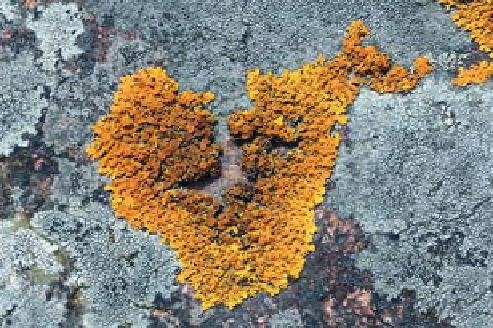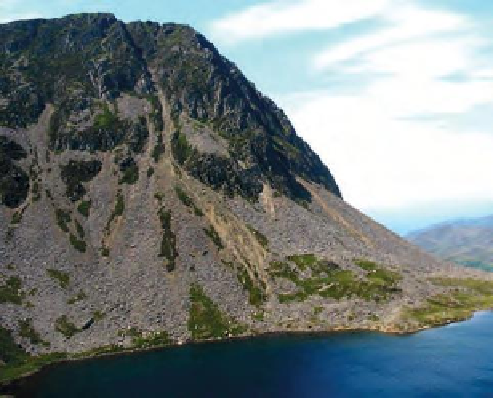Agriculture Reference
In-Depth Information
Table 12.1
Soil particle sizes
Soil Particle
Diameter (mm)
Stones
greater than 2
Coarse sand
0.6-2.0
Medium sand
0.2-0.6
Fine sand
0.06-0.2
Silt
0.002-0.06
Clay
less than 0.002
stones, boulders and so on. In the study of soils,
these have been classified according to their diameter
(Table 12.1). The weathering process also shapes the
particles, which are normally angular with sharp edges
when first formed but become more rounded as they
are weathered further, such as river washed pebbles,
or wind blown sand.
Figure 12.3
Lichen on rock. The respiration of this and
other organisms living on or near rocks increases the
carbon dioxide levels. This generates more carbonic
acid that reacts with some of the minerals in the rock
and leads to its disintegration
Distribution of rock fragments
Chemical weathering
The loose material produced by the weathering of
rocks is likely to be eroded, that is, moved to other
places. The main agents of erosion are gravity, water,
wind and glaciers.
Many of the chemicals that make up the rocks react
with the elements around them. Some are soluble
in water and others react with oxygen to form new
compounds. Rainfall is one of the main causes of
rock weathering because the water combines with
carbon dioxide in the air to form
carbonic acid
. This
dissolves away chalk and limestone and reacts with
many other minerals making up rock, resulting in their
disintegration.
Gravity
Loose rock fragments on slopes are moved downhill.
On steep slopes they fall under the effect of gravity to
form heaps of rock, '
scree
', where they come to rest
(Figure 12.4). On gentler slopes material is gradually
moved downhill under the influence of rainsplash
Biological weathering
This is the action of all organisms. Plants and animals,
large and small, lead to rocks being broken up from
the patches of lichens growing on rocks (Figure 12.3)
to the mining and quarrying by mankind that creates
rock debris in which soil forms.
It is the respiration process of aerobic organisms that
provides the carbon dioxide (see p. 116) which, when
combined with water, forms the carbonic acid. This
is particularly concentrated in the plant rootzone. It is
particularly significant in the continued breakdown of
rock, rock fragments and soil particles that tend to be
protected against physical weathering because they
are down below the soil surface. Roots also contribute
physically by growing into cracks and opening them
up; most gardeners come across this sort of damage
that can be done to paths and driveways.
The fragments from the weathered rock are the
basis of soils that form in the loose material over the
Earth's surface. The type of soil formed and how
useful it is for the growing plants depends greatly
on the proportions of the different sizes of these
particles, which are familiar to us as clay, silt, sand,
Figure 12.4
Scree. The rock weathered on steep
hillsides falls under the infl uence of gravity. The
eroded rock continues to break down to smaller and
smaller pieces by continued physical and chemical
weathering
































